托福TPO阅读话题分类-更新
- 格式:docx
- 大小:21.13 KB
- 文档页数:4
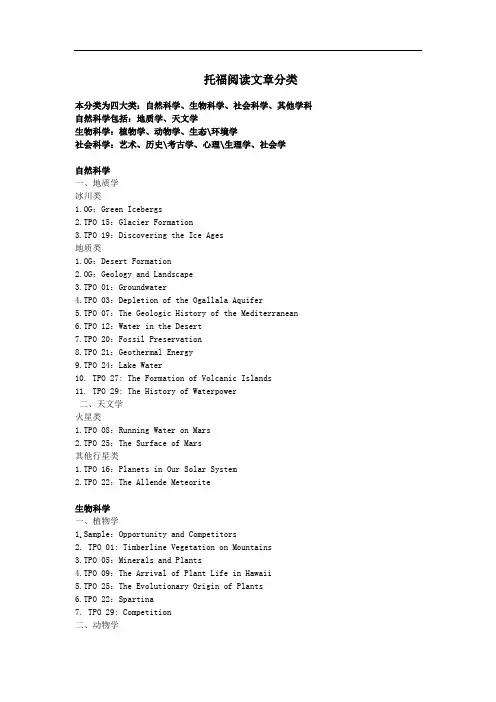
托福阅读文章分类本分类为四大类:自然科学、生物科学、社会科学、其他学科自然科学包括:地质学、天文学生物科学:植物学、动物学、生态\环境学社会科学:艺术、历史\考古学、心理\生理学、社会学自然科学一、地质学冰川类1.OG:Green Icebergs2.TPO 15:Glacier Formation3.TPO 19:Discovering the Ice Ages地质类1.OG:Desert Formation2.OG:Geology and Landscape3.TPO 01:Groundwater4.TPO 03:Depletion of the Ogallala Aquifer5.TPO 07:The Geologic History of the Mediterranean6.TPO 12:Water in the Desert7.TPO 20:Fossil Preservation8.TPO 21:Geothermal Energy9.TPO 24:Lake Water10. TPO 27: The Formation of Volcanic Islands11. TPO 29: The History of Waterpower二、天文学火星类1.TPO 08:Running Water on Mars2.TPO 25:The Surface of Mars其他行星类1.TPO 16:Planets in Our Solar System2.TPO 22:The Allende Meteorite生物科学一、植物学1.Sample:Opportunity and Competitors2. TPO 01: Timberline Vegetation on Mountains3.TPO 05:Minerals and Plants4.TPO 09:The Arrival of Plant Life in Hawaii5.TPO 25:The Evolutionary Origin of Plants6.TPO 22:Spartina7. TPO 29: Competition二、动物学动物特点1.OG:Swimming Machines2.OG:Feeding Habits of East African Herbivores3.TPO04:Deer Population of the Puget Sound4.TPO 13:Biological Clock5.TPO 15:A Warm-blooded Turtle6.TPO 17:Symbiotic Relationship7.TPO27: Buck Rubs and Buck Scrapes8.TPO27: Predator-Prey Cycle9.TPO 30: Role of Play in Development10.TPO 30: The Pace of Evolutionary Change动物变化1.Sample:Meteorite Impact and Dinosaur Extinction2.TPO 05:The Cambrian Explosion3.TPO 08:Extinction of The Dinosaurs4.TPO 15:Mass Extinctions动物行为1.TPO 02:The Origins of Cetaceans2. TPO 11:Orientation and Navigation3.TPO 11:Begging by Nestlings4.TPO 17:Animal Signals in The Rain Forest三、生态/环境学生态系统1.TPO 03:The Long-Term Stability of Ecosystems2.TPO 19:Succession, Climax, and Ecosystems3.TPO 26:Survival of Plants and Animals in Desert Conditions 环境特点1.Sample:Electricity from Wind2.TPO 04:Petroleum Resources3.TPO 10:Variations in the Climate4.TPO 18:Lightning5.TPO 23:Urban Climates社会科学一、艺术绘画/雕塑/陶瓷1.Sample:Lascaux Cave Paintings2.TPO04:Cave Art in Europe3.TPO 10:Chinese Pottery4.TPO 11:Ancient Egyptian Sculpture5.TPO 23:Rock Art of the Australian Aborigines6.TPO 27: Crafts in the Ancient New East建筑/戏剧/电影/1.OG:Applied Arts and Fine Arts2.TPO 01:The Origins of Theater3.TPO02:Early Cinema4.TPO03:Architecture5.TPO 12:Transition to Sound in Film6.TPO 22:The Birth of Photography二、历史/考古学工业化介绍1.OG:Artisans and Industrialization2.TPO 06:Powering the Industrial Revolution3.TPO 18:Industrialization in the Netherlands and Scandinavia4.TPO 26:Energy and the Industrial Revolution贸易/经济介绍1.TPO 10:Seventeenth-Century European Economic Growth2.TPO14:Pastoralism in Ancient Inner Eurasia3.TPO 16:Trade and the Ancient Middle East4.TPO 17:Europe’s Early Sea Trade with Asia5.TPO 25:The Decline of Venetian Shipping农业发展介绍1.TPO 07:Agriculture, Iron, and The Bantu Peoples2.TPO21:The Origins of Agriculture3.TPO 23:Seventeenth-Century Dutch Agriculture国家/城市特点1.OG:Nineteenth-Century Politics inThe United States2. TPO 08:The Rise of Teotihuacan3.TPO 07:Ancient Rome and Greece4.TPO 14:Maya Water Problems5.TPO 19:The Roman Army’s Impact on Britain6.TPO 26:Sumer and The First Cities of The Ancient Near East7.TPO 29: Characteristics of Roman Army人口变化特点1.TPO 05:The Origins of the Pacific Island People2.TPO 09:Colonizing the Americas Via The Northwest Coast3.TPO 20:Westward Migration4.TPO 20:Early Settlement in the Southwest Asia5.TPO 24:Moving into Pueblos三、心理/生理学1.OG:Aggression2.OG:The Expression of Emotion3.TPO 06:Infantile Amnesia4.TPO 13:Methods of Studying Infant Perception5.TPO 18:The Mystery of Yawning6.TPO 21:Autobiographical Memory7.TPO 24:Breathing during Sleep四、社会学1. TPO 14:Children and Advertising2.TPO 09:Reflection in Teaching3.TPO 13:Types of Social Groups其他学科类1.OG:Loie Fuller2.TPO 06:William Smith3.TPO 16:Development of the Periodic Table4.TPO 12:Which Hand Did They Use?5.TOP 28: Early Saharan Pastoralists6.TPO 30 The Invention of the Mechanical Clock。
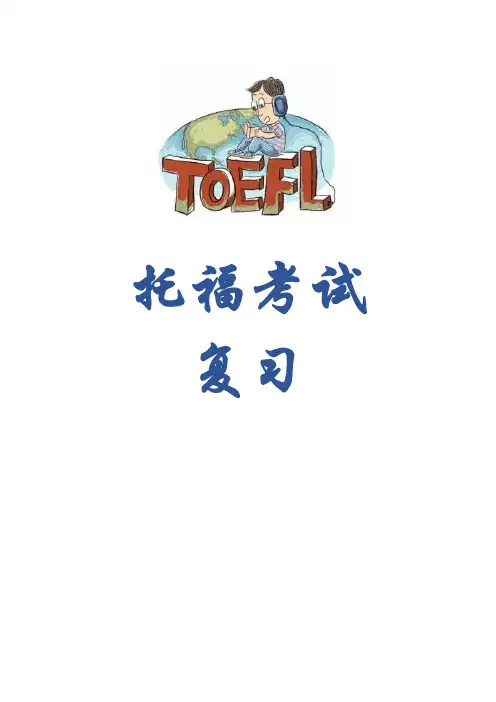
托福考试 复习托福阅读TPO13(试题+答案+译文)第1篇:Types of Social Groups托福阅读原文Life places us in a complex web of relationships with other people. Our humanness arises out of these relationships in the course of social interaction. Moreover, our humanness must be sustained through social interaction—and fairly constantly so. When an association continues long enough for two people to become linked together by a relatively stable set of expectations, it is called a relationship.People are bound within relationships by two types of bonds: expressive ties and instrumental ties. Expressive ties are social links formed when we emotionally invest ourselves in and commit ourselves to other people. Through association with people who are meaningful to us, we achieve a sense of security, love, acceptance, companionship, and personal worth. Instrumental ties are social links formed when we cooperate with other people to achieve some goal. Occasionally, this may mean working with instead of against competitors. More often, we simply cooperate with others to reach some end without endowing the relationship with any larger significance.Sociologists have built on the distinction between expressive and instrumental ties to distinguish between two types of groups: primary and secondary. A primary group involves two or more people who enjoya direct, intimate, cohesive relationship with one another. Expressive ties predominate in primary groups; we view the people as ends in themselves and valuable in their own right. A secondary group entails two or more people who are involved in an impersonal relationship and have come together for a specific, practical purpose. Instrumental ties predominate in secondary groups; we perceive people as means to ends rather than as ends in their own right. Sometimes primary group relationships evolve out of secondary group relationships. This happens in many work settings. People on the job often develop close relationships with coworkers as they come to share gripes, jokes, gossip, and satisfactions.A number of conditions enhance the likelihood that primary groups will arise. First, group size is important. We find it difficult to get to know people personally when they are milling about and dispersed in large groups. In small groups we have a better chance to initiate contact and establish rapport with them. Second, face-to-face contact allows us to size up others. Seeing and talking with one another in close physical proximity makes possible a subtle exchange of ideas and feelings. And third, the probability that we will develop primary group bonds increases as we have frequent and continuous contact. Our ties with people often deepen as we interact with them across time and gradually evolve interlocking habits and interests.Primary groups are fundamental to us and to society. First, primary groups are critical to the socialization process. Within them, infants and children are introduced to the ways of their society. Such groups are the breeding grounds in which we acquire the norms and values that equip us for social life. Sociologists view primary groups as bridges between individuals and the larger society because they transmit, mediate, and interpret a society's cultural patterns and provide the sense of oneness so critical for social solidarity.Second, primary groups are fundamental because they provide the settings in which we meet most of our personal needs. Within them, we experience companionship, love, security, and an overall sense of well-being. Not surprisingly, sociologists find that the strength of a group's primary ties has implications for the group's functioning. For example, the stronger the primary group ties of a sports team playing together, the better their record is.Third, primary groups are fundamental because they serve as powerful instruments for social control. Their members command and dispense many of the rewards that are so vital to us and that make our lives seem worthwhile. Should the use of rewards fail, members can frequently win by rejecting or threatening to ostracize those who deviate from the primary group's norms. For instance, some social groups employ shunning (a person can remain in the community, but others areforbidden to interact with the person) as a device to bring into line individuals whose behavior goes beyond that allowed by the particular group. Even more important, primary groups define social reality for us by structuring our experiences. By providing us with definitions of situations, they elicit from our behavior that conforms to group-devised meanings. Primary groups, then, serve both as carriers of social norms and as enforcers of them.托福阅读试题1.The word “complex”(Paragraph 1)in the passage is closest in meaning toA.delicateB.elaborateC.privatemon2.According to paragraph 1, which of the following is true of a relationship?A. It is a structure of associations with many people.B. It should be studied in the course of a social interaction.C. It places great demands on people.D. It develops gradually overtime.3.The word endowing in the passage(Paragraph 2)is closest in meaning toA.leavingB.exposingC. providingD. understanding4.Which of the following can be inferred about instrumental ties from the author's mention of working with competitors in paragraph 2?A. Instrumental ties can develop even in situations in which people would normally not cooperate.B.Instrumental ties require as much emotional investment as expressive ties.C. Instrumental ties involve security, love, and acceptance.D.Instrumental ties should be expected to be significant.5.According to paragraph 3, what do sociologists see as the main difference between primary and secondary groups?A.Primary groups consist of people working together, while secondary groups exist outside of work settings.B. In primary groups people are seen as means, while in secondary groups people are seen as ends.C. Primary groups involve personal relationships, while secondary groups are mainly practical in purpose.D.Primary groups are generally small, while secondary groups often contain more than two people.6.Which of the following can be inferred from the author's claim in paragraph 3 that primary group relationships sometimes evolve out of secondary group relationships?A.Secondary group relationships begin by being primary group relationships.B.A secondary group relationship that is highly visible quickly becomes a primary group relationship.C.Sociologists believe that only primary group relationships are important to society.D. Even in secondary groups, frequent communication serves to bring people into close relationships.7.The phrase “size up” in the passage(Paragraph 4)is closest in meaning toA.enlargeB.evaluateC. impressD. accept8.Which of the sentences below best expresses the essential information in the highlighted sentence(Paragraph 5)in the passage? Incorrect choices change the meaning in important ways or leave out essentialinformation.A.Sociologists think that cultural patterns establish connections between the individual and the larger society.B.Sociologists believe that individuals with a sense of oneness bridge the gap between society and primary groups.C.Sociologists think primary groups contribute to social solidarity because they help maintain a society's cultural patterns.D.Sociologists believe that the cultural patterns that provide social solidarity arise as bridges from primary groups.9.This passage is developed primarily byA.drawing comparisons between theory and practiceB.presenting two opposing theoriesC.defining important concepts and providing examples of themD.discussing causes and their effects10.The word “deviate” in the passage(Paragraph 7)is closest in meaning toA.detractB.advanceC.selectD.depart11.According to paragraph 7, why would a social group use shunning?A.To enforce practice of the kinds of behavior acceptable to the groupB.To discourage offending individuals from remaining in the groupC.To commend and reward the behavior of the other members of the groupD.To decide which behavioral norms should be passed on to the next generation12. Look at the four squares [■] that indicate where the following sentence could be added to the passage. Where would the sentence best fit? Look at the four squares [■] that indicate where the following sentence could be added to the passage. People who do not live alone, for example, tend to make healthier life choices and develop fewer pathologies than people who live by themselves. Where would the sentence best fit?Second, primary groups are fundamental because they provide the settings in which we meet most of our personal needs. ■【A】Within them, we experience companionship, love, security, and an overall sense of well-being. ■【B】Not surprisingly, sociologists find that the strength of a group's primary ties has implications for the group's functioning. ■【C】For example, the stronger the primary group ties of a sports team playing together, the better their record is. ■【D】13.Directions: Complete the table below by selecting three answer choices that are characteristics of primary groups and two answer choices that are characteristics of secondary groups. This question is worth 3points.A.Developing socially acceptable behaviorB. Working together against competitorsC.Experiencing pressure from outside forcesD.Viewing people as a means to an endE.Existing for practical purposesF.Providing meaning for life situationsG.Involving close relationships1 )Primary GroupsA B C D E F G2 )Secondary GroupsA B C D E F G托福阅读答案plex复杂的,所以B的elaborate正确。
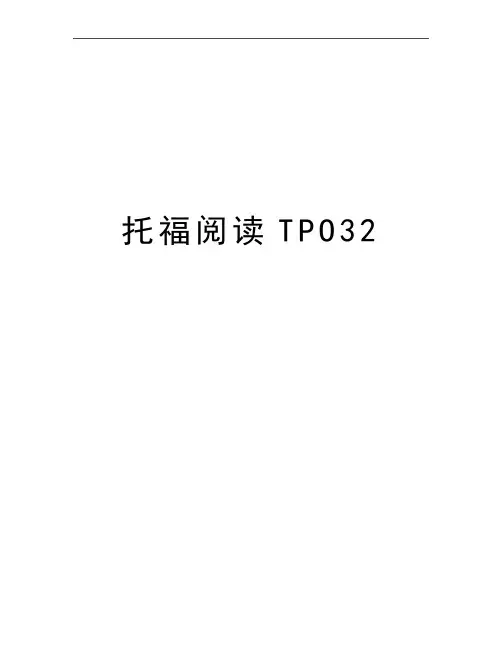
托福阅读T P O32托福阅读TPO32查看托福口语TPO1-34文本+MP3,请点击:托福TPO口语大全查看托福阅读TPO1-33阅读原文+题目+答案,请点击:托福TPO阅读大全查看托福听力TPO1-30原文+题目+MP3音频下载,请点击:托福TPO听力大全查看托福写作TPO1-25文本大全,请点击:托福TPO写作大全托福阅读TPO32第1篇:Plant ColonizationColonization is one way in which plants canchange the ecology of a site. Colonization is aprocess with two components: invasion andsurvival. The rate at which a site is colonized byplants depends on both the rate at which individualorganisms (seeds, spores, immature or mature individuals) arrive at the site and their successat becoming established and surviving. Success in colonization depends to a great extent onthere being a site available for colonization—a safe site where disturbance by fire or bycutting down of trees has either removed competing species or reduced levels of competitionand other negative interactions to a level at which the invading species can becomeestablished. For a given rate of invasion, colonization of a moist, fertile site is likely to bemuch more rapid than that of a dry, infertile site because of poor survival on the latter. Afertile, plowed field is rapidly invaded by a large variety of weeds, whereas a neighboringconstruction site from which the soil has beencompacted or removed to expose a coarse,infertile parent material may remain virtually free of vegetation for many months or even yearsdespite receiving the same input of seeds as the plowed field.殖民化是植物能够改变一个地方生态的一种方法。
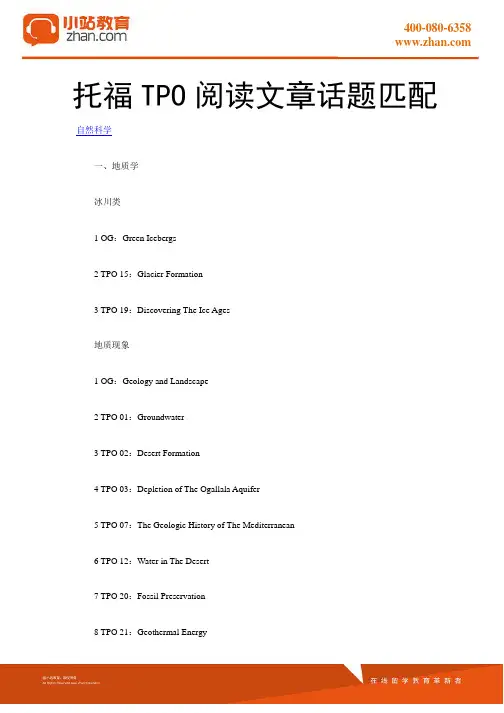
托福TPO阅读文章话题匹配自然科学一、地质学冰川类1 OG:Green Icebergs2 TPO 15:Glacier Formation3 TPO 19:Discovering The Ice Ages地质现象1 OG:Geology and Landscape2 TPO 01:Groundwater3 TPO 02:Desert Formation4 TPO 03:Depletion of The Ogallala Aquifer5 TPO 07:The Geologic History of The Mediterranean6 TPO 12:Water in The Desert7 TPO 20:Fossil Preservation8 TPO 21:Geothermal Energy9 TPO 24:Lake Water二、天文学火星类1 TPO 08:Running Water On Mars2 TPO 25:The Surface of Mars其他行星类1 TPO 16:Planets in Our Solar System2 TPO 22:The Allende Meteorite生物科学一、植物学1 Sample:Opportunity and Competitors2 TPO 01:Timberline Vegetation on Mountains3 TPO 05:Minerals and Plants4 TPO 09:The Arrival of Plant Life in Hawaii5 TPO 22:Spartina6 TPO 25:The Evolutionary Origin of Plants二、动物学动物特点1 OG:Swimming Machines2 OG:Feeding Habits of East African Herbivores3 TPO 04:Deer Population of The Puget Sound4 TPO 13:Biological Clock5 TPO 15:A Warm-blooded Turtle6 TPO 17:Symbiotic Relationship动物变化1 Sample:Meteorite Impact and Dinosaur Extinction2 TPO 05:The Cambrian Explosion3 TPO 08:Extinction of The Dinosaurs4 TPO 15:Mass Extinctions动物行为1 TPO 02:The Origins of Cetaceans2 TPO 11:Begging by Nestlings3 TPO 11:Orientation and Navigation4 TPO 17:Ani mal Signals in The Rain Forest三、生态/环境学生态系统1 TPO 03:The Long-Term Stability of Ecosystems2 TPO 19:Succession, Climax, and Ecosystems3 TPO 26:Survival of Plants and Animals in Desert Conditions 环境特点1 Sample:Electricity from Wind2 TPO 04:Petroleum Resources3 TPO 10:Variations in The Climate4 TPO 18:Lightning5 TPO 23:Urban Climates社会科学一、艺术绘画/雕塑/陶瓷1 Sample:Lascaux Cave Paintings2 TPO 04:Cave Art in Europe3 TPO 10:Chinese Pottery4 TPO 11:Ancient Egyptian Sculpture5 TPO 23:Rock Art of the Australian Aborigines建筑/戏剧/电影/摄影1 OG:Applied Arts and Fine Arts2 TPO 01:The Origins of Theater3 TPO 02:Early Cinema4 TPO 03:Architecture5 TPO 12:Transition to Sound in Film10 TPO 22:The Birth of Photography二、历史/考古学工业化介绍1 OG:Artisans and Industrialization2 TPO 06:Powering The Industrial Revolution3 TPO 18:Industrialization in The Netherlands and Scandinavia4 TPO 26:Energy and the Industrial Revolution贸易/经济介绍1 TPO 10:Seventeenth-Century European Economic Growth2 TPO14:Pastoralism in Ancient Inner Eurasia3 TPO 16:Trade and The Ancient Middle East4 TPO 17:Europe’s Early Sea Trade with Asia5 TPO 25:The Decline of Venetian Shipping农业发展介绍1 TPO 07:Agriculture, Iron, and The Bantu Peoples2 TPO21:The Origins of Agriculture3 TPO 23:Seventeenth-Century Dutch Agriculture国家/城市特点1 OG:Nineteenth-Century Politics in The United States2 TPO 07:Ancient Rome and Greece3 TPO 08:The Rise of Teotihuacan4 TPO 14:Maya Water Problems5 TPO 19:The Roman Army’s Impact on Britain6 TPO 26:Sumer and The First Cities of The Ancient Near East 人口变化特点1 TPO 05:The Origins of The Pacific Island People2 TPO 09:Colonizing The Americas Via The Northwest Coast3 TPO 20:Westward Migration4 TPO 20:Early Settlement in The Southwest Asia5 TPO 24:Moving into Pueblos三、心理/生理学1 OG:Aggression2 OG:The Expression of Emotion3 TPO06:Infantile Amnesia4 TPO 13:Methods of Studying Infant Perception5 TPO 18:The Mystery of Yawning6 TPO 21:Autobiographical Memory7 TPO 24:Breathing During Sleep四、社会学1 TPO09:Reflection in Teaching2 TPO 13:Types of Social Groups3 TPO 14:Childrenand Advertising其他学科类1 OG:Loie Fuller2 TPO 06:William Smith3 TPO 16:Development of The Periodic Table4 TPO 12:Which Hand Did They Use?以上就是关于托福阅读文章话题匹配(更新至TPO 26)的详细内容,希望对考生们复习托福阅读有所帮助,400-080-6358。
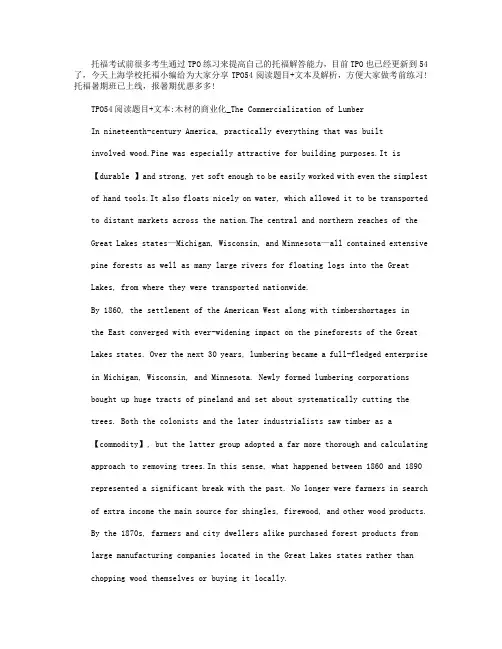
托福考试前很多考生通过TPO练习来提高自己的托福解答能力,目前TPO也已经更新到54了,今天上海学校托福小编给为大家分享TPO54阅读题目+文本及解析,方便大家做考前练习!托福暑期班已上线,报暑期优惠多多!TPO54阅读题目+文本:木材的商业化_The Commercialization of LumberIn nineteenth-century America, practically everything that was builtinvolved wood.Pine was especially attractive for building purposes.It is【durable 】and strong, yet soft enough to be easily worked with even the simplestof hand tools.It also floats nicely on water, which allowed it to be transportedto distant markets across the nation.The central and northern reaches of theGreat Lakes states—Michigan, Wisconsin, and Minnesota—all contained extensivepine forests as well as many large rivers for floating logs into the GreatLakes, from where they were transported nationwide.By 1860, the settlement of the American West along with timbershortages inthe East converged with ever-widening impact on the pineforests of the GreatLakes states. Over the next 30 years, lumbering became a full-fledged enterprisein Michigan, Wisconsin, and Minnesota. Newly formed lumbering corporationsbought up huge tracts of pineland and set about systematically cutting thetrees. Both the colonists and the later industrialists saw timber as a【commodity】, but the latter group adopted a far more thorough and calculatingapproach to removing trees.In this sense, what happened between 1860 and 1890represented a significant break with the past. No longer were farmers in searchof extra income the main source for shingles, firewood, and other wood products.By the 1870s, farmers and city dwellers alike purchased forest products fromlarge manufacturing companies located in the Great Lakes states rather thanchopping wood themselves or buying it locally.The commercialization of lumbering was in part the product of technologicalchange. The early, thick saw blades tended to waste a large quantity of wood,with perhaps as much as a third of the log left behind on the floor as sawdustor scrap. In the 1870s, however, the 【British-invented band saw】, with itsthinner blade, became standard issue in the Great Lakes states' lumberfactories.Meanwhile, the rise of steam-powered mills streamlined production by 【allowing for 】the more efficient, centralized, and continuous cutting of lumber.Steam helped to automate a variety of tasks, from cutting to the carrying awayof waste. Mills also employed steam to heat log ponds, preventing them fromfreezing and making possible year-round lumber production.For industrial lumbering to succeed, a way had to be found to neutralizethe effects of the seasons on production. Traditionally, cutting took place inthe winter, when snow and ice made it easier to drag logs on sleds or sleighs tothe banks of streams. Once the streams and lakes thawed, workers rafted the logsto mills, where they were cut into lumberin the summer. If nature did notcooperate—if the winter proved dry and warm, if the spring thaw wasdelayed—production would suffer. To counter the effects of climate on lumberproduction, loggers experimented with a variety of techniques for transportingtrees out of the woods. In the 1870s, loggers in the Great Lakes states begansprinkling water on sleigh roads, giving them an artificial ice coating tofacilitatetravel. The ice reduced the friction and allowed workers to movelarger and heavier loads.But all the sprinkling in the world would not save a logger from the threat。
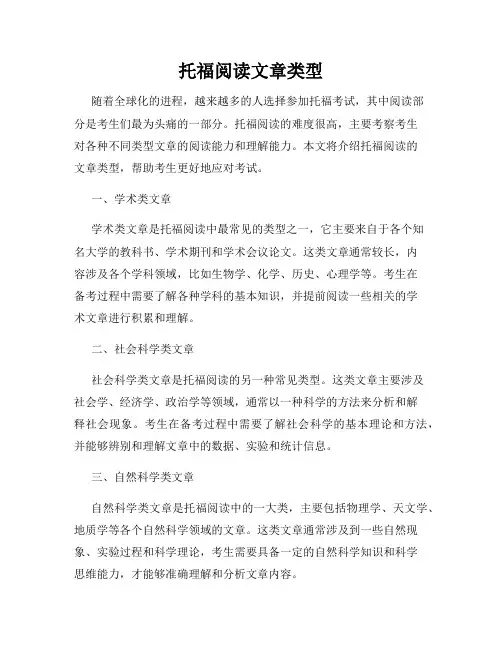
托福阅读文章类型随着全球化的进程,越来越多的人选择参加托福考试,其中阅读部分是考生们最为头痛的一部分。
托福阅读的难度很高,主要考察考生对各种不同类型文章的阅读能力和理解能力。
本文将介绍托福阅读的文章类型,帮助考生更好地应对考试。
一、学术类文章学术类文章是托福阅读中最常见的类型之一,它主要来自于各个知名大学的教科书、学术期刊和学术会议论文。
这类文章通常较长,内容涉及各个学科领域,比如生物学、化学、历史、心理学等。
考生在备考过程中需要了解各种学科的基本知识,并提前阅读一些相关的学术文章进行积累和理解。
二、社会科学类文章社会科学类文章是托福阅读的另一种常见类型。
这类文章主要涉及社会学、经济学、政治学等领域,通常以一种科学的方法来分析和解释社会现象。
考生在备考过程中需要了解社会科学的基本理论和方法,并能够辨别和理解文章中的数据、实验和统计信息。
三、自然科学类文章自然科学类文章是托福阅读中的一大类,主要包括物理学、天文学、地质学等各个自然科学领域的文章。
这类文章通常涉及到一些自然现象、实验过程和科学理论,考生需要具备一定的自然科学知识和科学思维能力,才能够准确理解和分析文章内容。
四、历史类文章历史类文章是托福阅读中的另一常见类型。
这类文章主要讲述历史事件、人物和文化。
考生在备考过程中需要熟悉不同历史时期的重大事件和主要人物,并能够理解和分析文章中的历史背景、原因和结果。
五、文学类文章文学类文章在托福阅读中较为罕见,但也不可避免地会出现。
这类文章通常是一些文学作品的片段或者相关评论和分析,考生需要具备一定的文学素养和理解能力,才能够理解和分析文章中的意义和主题。
六、实验类文章实验类文章在托福阅读中属于比较典型的类型之一。
这类文章主要描述了一些科学实验的目的、方法、结果与结论。
考生需要具备一定的科学实验的基本知识,并能够分析和理解实验结果和结论。
七、新闻报道类文章新闻报道类文章在托福阅读中也会偶尔出现。
这类文章主要是一些新闻媒体对一些社会事件、科技进展等进行报道。
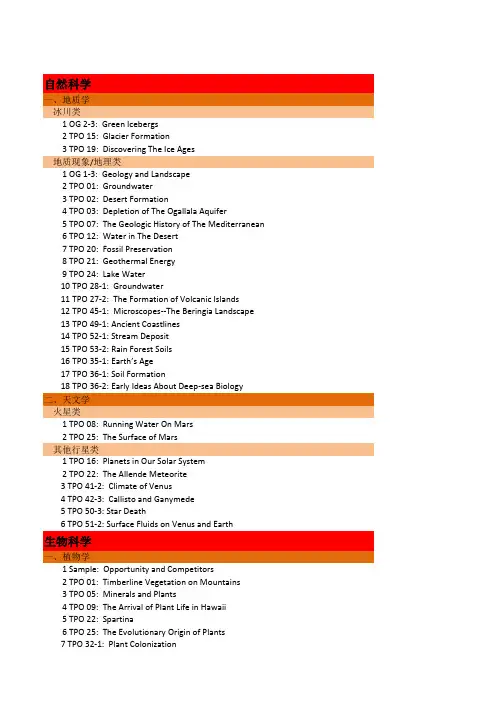
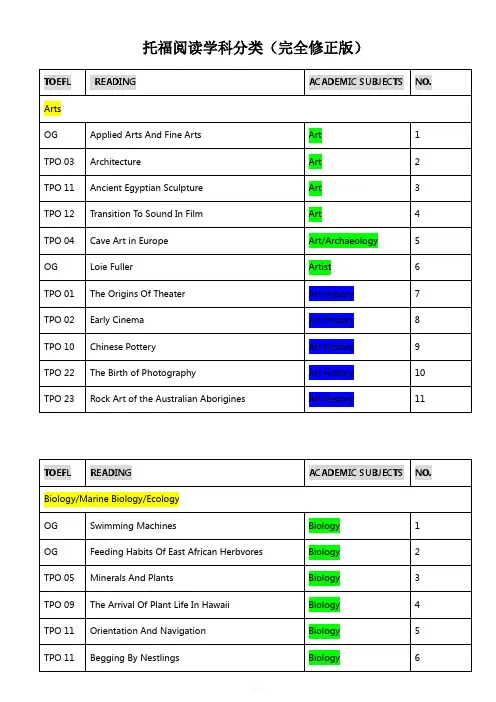
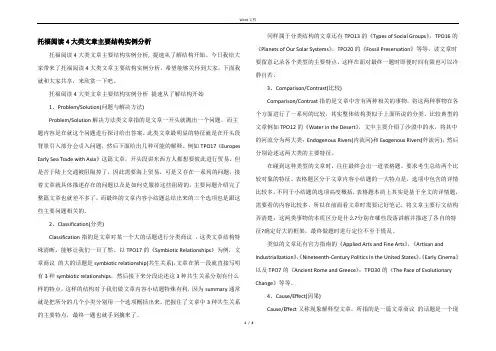
托福阅读4大类文章主要结构实例分析托福阅读4大类文章主要结构实例分析, 提速从了解结构开始。
今日我给大家带来了托福阅读4大类文章主要结构实例分析,希望能够关怀到大家,下面我就和大家共享,来欣赏一下吧。
托福阅读4大类文章主要结构实例分析提速从了解结构开始1、Problem/Solution(问题与解决方法)Problem/Solution解决方法类文章指的是文章一开头就抛出一个问题,而主题内容是在就这个问题进行探讨给出答案。
此类文章最明显的特征就是在开头段背景引入部分会引入问题,然后下面给出几种可能的解释。
例如TPO17《Europes Early Sea Trade with Asia》这篇文章,开头段讲东西方人都想要彼此进行贸易,但是苦于陆上交通被阻隔掉了,因此需要海上贸易,可是又存在一系列的问题。
接着文章就具体描述存在的问题以及是如何克服掉这些阻碍的。
主要问题介绍完了整篇文章也就差不多了,而最终的文章内容小结题总结出来的三个选项也是跟这些主要问题相关的。
2、Classification(分类)Classification指的是文章对某一个大的话题进行分类商议,这类文章结构特殊清晰,能够让我们一目了然。
以TPO17的《Symbiotic Relationships》为例,文章商议的大的话题是symbiotic relationship(共生关系),文章在第一段就直接写明有3种symbiotic relationships,然后接下来分段论述这3种共生关系分别有什么样的特点。
这样的结构对于我们做文章内容小结题特殊有利,因为summary通常就是把所分的几个小类分别用一个选项概括出来。
把握住了文章中3种共生关系的主要特点,最终一题也就手到擒来了。
同样属于分类结构的文章还有TPO13的《Types of Social Groups》,TPO16的《Planets of Our Solar Systems》,TPO20的《Fossil Preservation》等等,读文章时要留意记录各个类型的主要特点,这样在面对最终一题时即便时间有限也可以冷静自若。
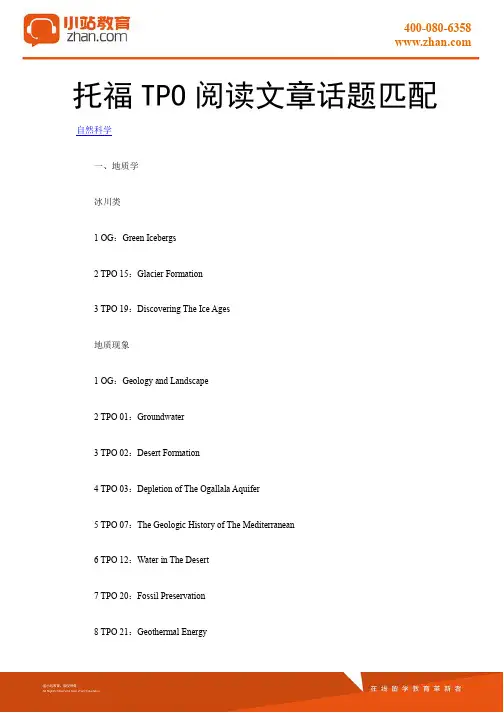
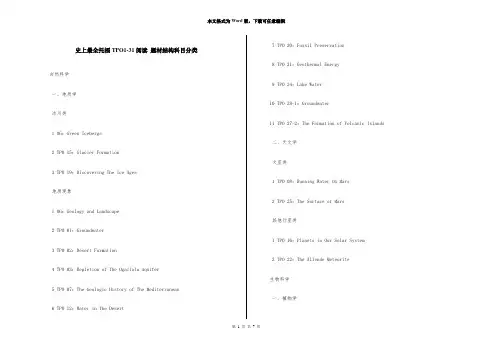
史上最全托福TPO1-31阅读题材结构科目分类自然科学一、地质学冰川类1 OG:Green Icebergs2 TPO 15:Glacier Formation3 TPO 19:Discovering The Ice Ages地质现象1 OG:Geology and Landscape2 TPO 01:Groundwater3 TPO 02:Desert Formation4 TPO 03:Depletion of The Ogallala Aquifer5 TPO 07:The Geologic History of The Mediterranean6 TPO 12:Water in The Desert7 TPO 20:Fossil Preservation8 TPO 21:Geothermal Energy9 TPO 24:Lake Water10 TPO 28-1:Groundwater11 TPO 27-2:The Formation of Volcanic Islands二、天文学火星类1 TPO 08:Running Water On Mars2 TPO 25:The Surface of Mars其他行星类1 TPO 16:Planets in Our Solar System2 TPO 22:The Allende Meteorite生物科学一、植物学1 Sample:Opportunity and Competitors2 TPO 01:Timberline Vegetation on Mountains3 TPO 05:Minerals and Plants4 TPO 09:The Arrival of Plant Life in Hawaii5 TPO 22:Spartina6 TPO 25:The Evolutionary Origin of Plants二、动物学动物特点1 OG:Swimming Machines2 OG:Feeding Habits of East African Herbivores3 TPO 04:Deer Population of The Puget Sound4 TPO 13:Biological Clock5 TPO 15:A Warm-blooded Turtle6 TPO 17-3:Symbiotic Relationship动物变化1 Sample:Meteorite Impact and Dinosaur Extinction2 TPO 05:The Cambrian Explosion3 TPO 08:Extinction of The Dinosaurs4 TPO 15:Mass Extinctions5 TPO 31-1: Speciation in Geographically Isolated Populations6 TPO 30-2: The Pace of Evolutionary Change动物行为1 TPO 02:The Origins of Cetaceans2 TPO 11:Begging by Nestlings3 TPO 11:Orientation and Navigation4 TPO 17:Ani mal Signals in The Rain Forest5 TPO 30-1 Role of Play in Development6 TPO 29-2:Competition7 TPO 28-3:Buck Rubs and Buck Scrapes8 TPO 27-3:Predator-Prey Cycles三、生态/环境/能源1 TPO 03:The Long-Term Stability of Ecosystems2 TPO 19:Succession, Climax, and Ecosystems3 TPO 26:Survival of Plants and Animals in Desert Conditions4 TPO 31-3: Savanna Formation1 Sample:Electricity from Wind2 TPO 04:Petroleum Resources3 TPO 29-3:The History of Waterpower3 TPO 10:Variations in The Climate4 TPO 18:Lightning5 TPO 23:Urban Climates社会科学一、艺术绘画/雕塑/陶瓷1 Sample:Lascaux Cave Paintings2 TPO 04:Cave Art in Europe3 TPO 10:Chinese Pottery4 TPO 11:Ancient Egyptian Sculpture5 TPO 23:Rock Art of the Australian Aborigines6 TPO 29-1:Characteristics of Roman Pottery7 TPO27-1:Crafts in the Ancient near East建筑/戏剧/电影/摄影1 OG:Applied Arts and Fine Arts2 TPO 01:The Origins of Theater3 TPO 02:Early Cinema4 TPO 03:Architecture5 TPO 12:Transition to Sound in Film10 TPO 22:The Birth of Photography二、历史/考古学工业化介绍1 OG:Artisans and Industrialization2 TPO 06:Powering The Industrial Revolution3 TPO 18:Industrialization in The Netherlands and Scandinavia4 TPO 26:Energy and the Industrial Revolution5 TPO 30-3: The Invention of the Mechanical Clock贸易/经济介绍1 TPO 10:Seventeenth-Century European Economic Growth2 TPO14:Pastoralism in Ancient Inner Eurasia3 TPO 16:Trade and The Ancient Middle East4 TPO 17:Europe’s Early Sea Trade with Asia5 TPO 25:The Decline of Venetian Shipping农业发展介绍 1 TPO 07:Agriculture, Iron, and The Bantu Peoples2 TPO21:The Origins of Agriculture3 TPO 23:Seventeenth-Century Dutch Agriculture国家/城市特点1 OG:Nineteenth-Century Politics in The United States2 TPO 07-2:Ancient Rome and Greece3 TPO 08:The Rise of Teotihuacan4 TPO 14:Maya Water Problems5 TPO 19:The Roman Army’s Impact on Britain6 TPO 26:Sumer and The First Cities of The Ancient Near East 人口变化特点1 TPO 05:The Origins of The Pacific Island People2 TPO 09:Colonizing The Americas Via The Northwest Coast3 TPO 20:Westward Migration4 TPO 20:Early Settlement in The Southwest Asia5 TPO 24:Moving into Pueblos6 TPO 28-2: Early Saharan Pastoralists三、心理/生理学1 OG:Aggression2 OG:The Expression of Emotion3 TPO06:Infantile Amnesia4 TPO 13:Methods of Studying Infant Perception5 TPO 18:The Mystery of Yawning6 TPO 21:Autobiographical Memory7 TPO 24:Breathing During Sleep四、社会学1 TPO09:Reflection in Teaching2 TPO 13:Types of Social Groups3 TPO 14:Childrenand Advertising4 TPO 31-2: Early Children Education其他学科类1 OG:Loie Fuller2 TPO 06:William Smith3 TPO 16:Development of The Periodic Table4 TPO 12:Which Hand Did They Use?结构体裁难度系数现象到解释:形成过程Exposition 现象到解释:形成过程Exposition现象到解释:形成过程:对比Exposition现象到解释Exposition现象到解释:原因:分类Exposition现象到解释Exposition现象到解释:形成过程Historical现象到解释:分类Exposition现象到解释Exposition现象到解释Exposition5现象到解释:对比Exposition 现象到解释:对比Exposition现象到解释Exposition现象到解释:总分Historical现象到解释Exposition现象到解释Exposition现象描述:分类Exposition现象到解释:分类Exposition现象到解释(含研究)理论解释(新旧对比)现象到解释(含研究)Exposition现象描述:分类Exposition现象到解释(含研究)Exposition现象到解释(含研究)Exposition现象到解释(含研究)Exposition现象到解释(含研究)Exposition现象到解释Exposition现象到解释总分:分类起源及发展Historical起源及发展Historical现象到解释:形成过程Exposition现象到解释总分:分类Historical HistoricalHistoricalHistoricalHistorical 现象到解释Historical 现象到解释Historical现象描述:分类Exposition起源及发展Historicalcandinavia起源及发展Historical现象到解释:总分Historical现象到解释:总分HistoricalHistorical 现象到解释:总分:Classificatio现象到解释: Classification Historical 现象到解释:总分Historical Exposition 现象到解释:总分:Classificatio现象到解释(含研究)Exposition 现象到解释(含研究)。
托福TPO分类听力练习对话1 学生与图书馆管理员:TPO13C2 / TPO9C2/TPO1C1 / TPO14C1/TPO4C1 / TPO10C22 学生与老师谈论文:TPO6C2 /TPO12C1 / TPO13C1 /TPO22C2 / TPO17C1谈problem:TPO21C2/ TPO23C2/TPO16C2 /TPO10C1 /TPO4C2生物1, 动物行为:/ Tpo3l1 habitat/ Tpo8l1 habitat selection / Tpo16l3 foraging2, 动物的超能力:Tpo20l4 躲避天敌/ Tpo18l4冬眠/ Tpo9l4 linguistics 动物语言/ Tpo23L3 dolphin发声法/ Tpo24l1 crocodile vocalization3, 珍稀动植物:TPO6l2 澳洲珍稀物种4, 动植物进化史:Tpo21l3 毒蛇/ Tpo24l3 megafauna (mammoth)5, 动植物与环境的互动:Tpo13l2 海狸/ Tpo22l3 人类活动的影响6, 生理:Tpo12l1 染色体艺术史1, 艺术形式:Tpo12l3 opera/ Tpo16l2 piano/ Tpo18l2 sculpture/ Tpo23l4 choreography2, 技术手段:Tpo15l3 莎草纸/ Tpo16l4 着色玻璃/ TPO17L1 radio-carbon dating3, 艺术史上的知名人物:Tpo1l1 当代绘画艺术家/ Tpo24l2 modern dance: a ballerina4, 文学1),文学形式:Tpo20l3 folktale2),文学人物3),其它:Tpo6l3 writing天文1,天体形成的过程/天体物质2,天文观测手段:Tpo3l4 spectroscopy3,对某些现象的假想:Tpo24l4 shield volcano on Venus4,知名天文现象:Tpo18l1 太阳黑子5,人类对天文知识的应用:Tpo14l3 navigation地质1,一些地质现象形成的原因:TPO16L1 Lechuguilla2,地质勘探手段:Tpo1l2 uranium-lead dating technique3,一些知名的地质现象:Tpo20l2 ice age4,环境科学:Tpo11l3 wetlands/ Tpo17l2 地球绕太阳影响气候/ Tpo23l2反照率。
托福阅读文章的话题分类为了帮助大家高效备考托福,为大家带来托福阅读文章的话题分类,希望对大家托福备考有所帮助。
更多精彩尽请关注!托福阅读文章的话题分类1. 人:学术阅读中最常出现的就是各种科学家,以ist和er结尾居多。
例如:anthropologist,archaeologist,paleontologist,zoologist,geographer,astronomer(人类学家,考古学家,古生物学家,动物学家,地理学家,天文学家)这类的词汇大家无需记住拼写,只要在阅读中出现可以辨认就足以。
在面对未知的专有名词时,至少要判断他们存在于那个学科,才好进行下一步的推理。
2. 地质、地貌:这类文章在托福学术阅读中比重很大。
建议大家对常用词汇进行积累。
例如:volcano,layer,conglomerate,karst,porous,permeable,meteorolite,asteroid火山,(地)层,砾岩,喀斯特地貌(石灰岩的一种地形),多孔的(有透气性与透水性),可渗透的,陨石,小行星3. 气候、动物与生态:与生物和地球有关的话题是托福永远的宠儿。
例如:unpredictable,vary,range from,extinction,endangered,tropical,jungle,equatorial不可预测的,改变(动词),变化幅度(动词),灭绝,濒危的,热带的,丛林,赤道附近的4. 历史、考古,这类题材是分水轮流转的对象,也要加以注意。
尤其是历史文章的考法不是单纯的讲古,而是从各个层面切入,有很多的表现形式。
可能是古人类的迁徙,那就是人类历史。
贸易和交通运输的发展,那就是经济史,等等。
例如,relics,remains,mausoleum,handicraft,cohesiveness,territorial,civilization遗迹,遗迹或残骸,陵墓,手工艺品,凝聚性,领土的,文明新托福阅读背景知识:脚尖的艺术脚尖的艺术从运动的实际需要来看,脚尖鞋的发明能够将舞者身体的重量支撑“面”经过若干倍的缩小后变成支撑“点”,从而有效地减小与地面的摩擦力,提高旋转的速度,造成风驰电掣的效果、超凡脱俗的幻觉,进而更好地为仙凡之恋这类虚幻的芭蕾题材服务。
托福TPO1-49阅读分类题材介绍托福TPO1-49阅读分类题材介绍!托福阅读考试文章的题材也是偏好的,大家在复习的时候,掌握好这些题材的分类,对于我们的考试也是有一定的帮助的下面小编为大家整理了详细的内容,供大家参考!托福TPO1-49阅读分类题材介绍TPO 1-10(2篇)TPO 7: Ancient Rome and GreeceTPO 8: The Rise of TeotihuacanTPO 11-20(3篇)TPO 16: Trade and the Ancient Middle EastTPO 17: Europe’s Early Sea Trade with AsiaTPO 20: Early Settlements in the Southwest AsiaTPO 21-30(2篇)TPO 24: Moving into PueblosTPO 26: Sumer and the First Cities of the Ancient Near East TPO 31-40(4篇)TPO 32: Siam, 1851-1910TPO 33: The First CivilizationTPO 35: Europe in the twelfth centuryTPO 40: Ancient AthensTPO 41-50(3篇)TPO 41: Trade and Early State FormationTPO 46: The Commercial Revolution in Medieval EuropeTPO 47: Roman Cultural Influence on Britain由此总结,托福TPO阅读中历史地理城市类题材,此类文章在历史上共计出现过14篇,那么按照总数150篇范围来估算比例(14/150 = 9%),我们可以得出该类型的文章在历史上的重现比例为9%,接近每10篇就会出现一篇的概率,绝对是高产概率。
托福阅读文章分类
本分类为四大类:自然科学、生物科学、社会科学、其他学科自然科学包括:地质学、天文学
生物科学:植物学、动物学、生态\环境学
社会科学:艺术、历史\考古学、心理\生理学、社会学
自然科学
一、地质学
冰川类
1.OG:Green Icebergs
2.TPO 15:Glacier Formation
3.TPO 19:Discovering the Ice Ages
地质类
1.OG:Desert Formation
2.OG:Geology and Landscape
3.TPO 01:Groundwater
4.TPO 03:Depletion of the Ogallala Aquifer
5.TPO 07:The Geologic History of the Mediterranean
6.TPO 12:Water in the Desert
7.TPO 20:Fossil Preservation
8.TPO 21:Geothermal Energy
9.TPO 24:Lake Water
10. TPO 27: The Formation of Volcanic Islands
11. TPO 29: The History of Waterpower
二、天文学
火星类
1.TPO 08:Running Water on Mars
2.TPO 25:The Surface of Mars
其他行星类
1.TPO 16:Planets in Our Solar System
2.TPO 22:The Allende Meteorite
生物科学
一、植物学
1.Sample:Opportunity and Competitors
2. TPO 01: Timberline Vegetation on Mountains
3.TPO 05:Minerals and Plants
4.TPO 09:The Arrival of Plant Life in Hawaii
5.TPO 25:The Evolutionary Origin of Plants
6.TPO 22:Spartina
7. TPO 29: Competition
二、动物学
动物特点
1.OG:Swimming Machines
2.OG:Feeding Habits of East African Herbivores
3.TPO04:Deer Population of the Puget Sound
4.TPO 13:Biological Clock
5.TPO 15:A Warm-blooded Turtle
6.TPO 17:Symbiotic Relationship
7.TPO27: Buck Rubs and Buck Scrapes
8.TPO27: Predator-Prey Cycle
9.TPO 30: Role of Play in Development
10.TPO 30: The Pace of Evolutionary Change
动物变化
1.Sample:Meteorite Impact and Dinosaur Extinction
2.TPO 05:The Cambrian Explosion
3.TPO 08:Extinction of The Dinosaurs
4.TPO 15:Mass Extinctions
动物行为
1.TPO 02:The Origins of Cetaceans
2. TPO 11:Orientation and Navigation
3.TPO 11:Begging by Nestlings
4.TPO 17:Animal Signals in The Rain Forest
三、生态/环境学
生态系统
1.TPO 03:The Long-Term Stability of Ecosystems
2.TPO 19:Succession, Climax, and Ecosystems
3.TPO 26:Survival of Plants and Animals in Desert Conditions 环境特点
1.Sample:Electricity from Wind
2.TPO 04:Petroleum Resources
3.TPO 10:Variations in the Climate
4.TPO 18:Lightning
5.TPO 23:Urban Climates
社会科学
一、艺术
绘画/雕塑/陶瓷
1.Sample:Lascaux Cave Paintings
2.TPO04:Cave Art in Europe
3.TPO 10:Chinese Pottery
4.TPO 11:Ancient Egyptian Sculpture
5.TPO 23:Rock Art of the Australian Aborigines
6.TPO 27: Crafts in the Ancient New East
建筑/戏剧/电影/
1.OG:Applied Arts and Fine Arts
2.TPO 01:The Origins of Theater
3.TPO02:Early Cinema
4.TPO03:Architecture
5.TPO 12:Transition to Sound in Film
6.TPO 22:The Birth of Photography
二、历史/考古学
工业化介绍
1.OG:Artisans and Industrialization
2.TPO 06:Powering the Industrial Revolution
3.TPO 18:Industrialization in the Netherlands and Scandinavia
4.TPO 26:Energy and the Industrial Revolution
贸易/经济介绍
1.TPO 10:Seventeenth-Century European Economic Growth
2.TPO14:Pastoralism in Ancient Inner Eurasia
3.TPO 16:Trade and the Ancient Middle East
4.TPO 17:Europe’s Early Sea Trade with Asia
5.TPO 25:The Decline of Venetian Shipping
农业发展介绍
1.TPO 07:Agriculture, Iron, and The Bantu Peoples
2.TPO21:The Origins of Agriculture
3.TPO 23:Seventeenth-Century Dutch Agriculture
国家/城市特点
1.OG:Nineteenth-Century Politics inThe United States
2. TPO 08:The Rise of Teotihuacan
3.TPO 07:Ancient Rome and Greece
4.TPO 14:Maya Water Problems
5.TPO 19:The Roman Army’s Impact on Britain
6.TPO 26:Sumer and The First Cities of The Ancient Near East
7.TPO 29: Characteristics of Roman Army
人口变化特点
1.TPO 05:The Origins of the Pacific Island People
2.TPO 09:Colonizing the Americas Via The Northwest Coast
3.TPO 20:Westward Migration
4.TPO 20:Early Settlement in the Southwest Asia
5.TPO 24:Moving into Pueblos
三、心理/生理学
1.OG:Aggression
2.OG:The Expression of Emotion
3.TPO 06:Infantile Amnesia
4.TPO 13:Methods of Studying Infant Perception
5.TPO 18:The Mystery of Yawning
6.TPO 21:Autobiographical Memory
7.TPO 24:Breathing during Sleep
四、社会学
1. TPO 14:Children and Advertising
2.TPO 09:Reflection in Teaching
3.TPO 13:Types of Social Groups
其他学科类
1.OG:Loie Fuller
2.TPO 06:William Smith
3.TPO 16:Development of the Periodic Table
4.TPO 12:Which Hand Did They Use?
5.TOP 28: Early Saharan Pastoralists
6.TPO 30 The Invention of the Mechanical Clock。